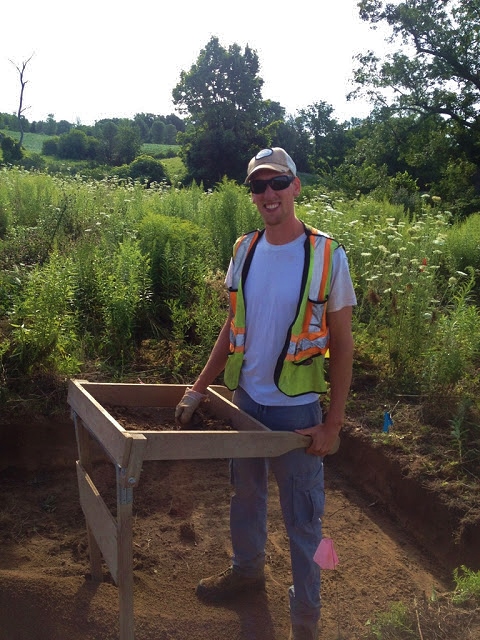
As an archaeological field technician working with ASI I have developed a profound appreciation for the archaeological history of the Great Lakes Region.
In the field, one has the pleasure of working in direct contact with a vast wealth of cultural material and physical and geographical features that hint at past life-ways. Many of us strive to learn many technical skills as an ASI Field Technician such as artifact identification, mapping and understanding the grid, profile drawing and site formation processes to name a few. These skills are invaluable to archaeologists and teach us how to practice honest archaeological methodology and documentation. However, many technicians may not have direct experience with the artifacts themselves and this poses a challenge when undertaking an academic or theoretical project. How and why are flakes created? Can one determine the stage of bifacial production from using macro-identification techniques?
As an undergraduate at the University of Waterloo, I decided to delve into a project that would challenge my understanding of bifacial reduction processes and knapped tool creation, a skill utilized by groups of First Nations peoples for thousands of years. The collection of artifacts that I had the pleasure of analyzing was from a site ASI excavated just east of Whitby, Ontario. Robert MacDonald gave the artifacts to me to use as a project for my Honours Thesis. The site, AlGr-222, contained a variety of formal knapped stone tools including an Archaic Broad point, a drill and a scraper.
Immediately something else sparked my attention. Nearly all of the lithic debitage in the collection (along with the formal tools) were made of Onondaga chert, while a collection of Ancaster preforms was strongly represented among the bifacial implements. Interestingly, there was almost little or no Ancaster chert debitage. I decided to develop a research project focusing on the stages of bifacial production for the group of preforms to determine whether or not the preforms were part of a cache of stored implements. To do this, I needed to understand basic flint knapping techniques and a general knowledge of flake production sequences. Unfortunately, I hadn’t had the time to analyze the thousands of flakes that I had found in the field over the past few summers, so up until the time I started my thesis, my knowledge of flaked debitage was strictly related to the identification of the material rather than how the material was created, or more importantly WHY it was created.
If you’ve ever seen 2,000 flakes and a few formal tools all of various sizes in one box before, you’d realize the type of challenge I set myself up for.
Where the heck do I start? So… I gathered a wealth of literature sources, gained some flint knapping experience and developed an approach to analyze and collect data from the group of artifacts ASI had given me. Thankfully, I had two great supervisors to help me along the way! The biggest challenge that I came across was the difficulty identifying flakes that had been produced by different forms of production. For example, flakes that are produced by soft hammer production have different attributes than flakes produced by pressure flaking. This information was crucial in relation to my research project and it took me some time to get the hang of the analysis. For many hours, I looked at physical characteristics of striking platforms and various measurements of the flakes and preforms and became comfortable grouping the flakes into clusters based on each of their respectful production application. Finally, I began to see some correlations.
Interestingly enough the percentage of flakes created by soft hammer percussion and flakes that were produced by pressure flaking were abundant in the collection and made up most of the debitage. This suggested that the flakes were late stage production flakes and that bifacial implements (including preforms and formal tools) were being knapped on the site.

I gathered information on the preforms too. Measurements and attributes helped me determine that the bifaces were all in similar stages of production, and were likely cached. After making these confirmations, I still had a few questions to ask myself. Why were the inhabitants of AlGr-222 creating formal tools made of Onondaga preforms but not reducing the Ancaster preforms? Why were the Ancaster preforms stored and still functionally sound? Why keep a cache of Ancaster bifaces around when an abundance of a higher quality chert source was available? Upon completion, I determined that there may be several answers to this question that may not be strictly related to the function of the Ancaster preforms. Perhaps the Ancaster preforms were kept for spiritual use? Maybe they were stored in expectation of future use? These theories may all be equally possible, but as archaeologists we realize that there may not a definitive answer and we continue asking ourselves questions.
Upon completion of the project, not only did I feel more confident in the field identifying flakes, but the experience working on a collection of lithic material also helped me visualize how the flakes were created.
I believe having field and lab experience creates a well-rounded archaeologist – the field, bringing context and cultural material to the table while the lab produces quantifiable data that can be used to better support the collection from the field.
Not only have I gained the ability to determine whether flakes are in early or later stages of production, when they were produced, but also, a general understanding of the type of production technique that was used to create the tools and lithic waste. This information can be utilized to help archaeologists and students like myself to determine what type of tools were being created at an archaeological site and can shed light on the types of activities that were undertaken on the site a long time ago.









